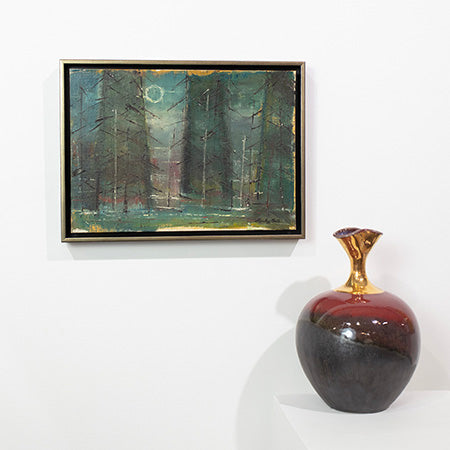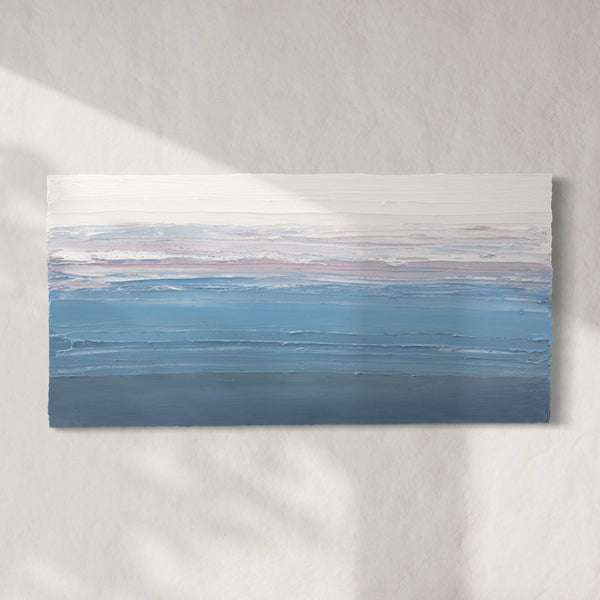As we near the end of the summer season, we're selecting a Curator's Choice that feels like an ode to quiet summer nights. Moonlit Pines by modern artist, Stanley Bate captures an abstracted landscape scene, with deep, shadowy trees etched over a teal backdrop, the subtlest outline of a white moon, and warm golden accents throughout. With two supermoons on display in August, a month when we're still able to savor cool evenings under the stars, we're diving in to why we love this piece and all the end-of-summer-feels it has to offer.
What It's About
"Our best guess is that this is a scene from his home in Caryville, NY in the Hudson Valley," says art appraisal specialist, Bernadette Giardina. "Bate didn't date his paintings or keep [consistent] records."
Although we don't have a precise creation date, Moonlit Pines was painted sometime around the year 1960. Stanley Bate, who was a New York painter that worked alongside prominent Abstract Expressionists like Mark Rothko and Jackson Pollock painted with the intent of expressing a feeling above all else. “Art is not an object, but an experience," Bate said. "To be able to perceive it; we need to be receptive… [to] the metaphysical quality - I would rather have it convey itself to the viewer. My paintings have no predetermined plan. They are usually worked out on the canvas. Their source may be subconscious, intuitive, unknown. I try to complete a painting in the shortest period of time in order to preserve the initial impulse. Whether my very personal feeling is communicated to the viewer, I don’t really care, nor do I think it makes any difference. It makes me paint, and I am gratified if someone finds some joy in my paintings.”

Where It Works
Moonlit Pines is small in size, measuring just 10" x 14" and 11.25" x 15.25" framed. It also features a deep, rich palette. For that reason, we love it in smaller, intimate spaces that still get plenty of use - in a reading nook, above a bedside table, or a small wall in an entryway are a few great options. Wherever it goes, though, Moonlit Pines will likely bring an undeniable sense of peace and contemplation to its surroundings.
Why We Love It
As a contemporary of New York Abstract Expressionists, Stanley Bate's work as a whole is consistent with the movement, in that it is driven by emotion and the subconscious. But in Moonlit Pines, Bate swaps the typical warm palettes, contorted figures, and pure abstraction we know from his greater body of work for something more subtle and almost traditional. Although it's a slight departure from his later renderings, he seems to retain his impulsive style and energy in a space that's just more familiar to the viewer. Maybe the sporadic strokes that form the tree branches are reminiscent of the uncertainty of a forest at night, but he doesn't remove the sense of peace we know the forest, or any natural environment has to offer - he meets us halfway, marrying the complex and often chaotic nature of emotion, with something as simple, untroubled, and serene as trees under the moon.
About Stanley Bate
Stanley Bate was born on March 26, 1903 in Nashville, Tennessee to Henry C. and Nellie E. Freeman Bate. Part of a well-established Tennessee family, Bate went on to study art at the Watkins Institute in Nashville.
In the 1920’s Stanley Bate moved to New York City to study at the Art Students League under Frederick Bridgman. He soon landed a job with Encyclopedia Britannica, and from 1927-1929 served as Art Editor. From 1929 until his death in 1972, Stanley was a self-employed artist. He taught art classes at both the Art Students League and the Albany Institute of History and Art and brought in extra income by making illustrations for magazines.
Stanley Bate’s time in New York City was pivotal in the formation of his painting style. He lived in New York during the inception of one of the most important Modern Art movements, one that helped New York replace Paris as the center of avant-garde art. This movement, which was called the New York School of artists, was later known as Abstract Expressionism. It was comprised of a loosely associated group of vanguard artists working in New York City during the 1940’s and 1950’s. The New York School was not defined by a specific style, but instead reflected a fusion of European Modernism and American social relevancy that was depicted in many individual styles. Influences of Surrealism, Cubism, and Modernism can be found in their work, along with an interest in experimenting with non-traditional materials and methods.
Stanley Bate was undoubtedly exposed to the varied styles and techniques that were emerging during the formative years of the New York School. Mark Rothko and Robert Motherwell were formulating their versions of color field paintings. Joseph Cornell was experimenting with assemblages, collage and the use of different types of textured paints. Jackson Pollock was adhering objects such as buttons and coins into his early works, while Louise Nevelson was using found objects. Helen Frankenthaler added sand to her early paintings. The New York School artists were undermining traditional fine art by using mixed media and non-traditional methods.
Stanley Bate absorbed these varied influences and soon his early realistic landscapes and still life paintings were replaced with something entirely new. The influence of Cubism, notably the flat shallow space of the picture plane, is obvious in many of Bate’s paintings. Surrealism is evident in Bate’s use of subjects from myth, primitive art and antiquity, along with the Automatism-like line work in his more linear images. The unfettered experimentation of the New York School is everywhere in Stanley Bate’s work. We see nods to color field, collage, the mixing of textures into paint, mixed media, the inclusion of found objects and thick, luscious impasto.
Bate was prolific and experimented in various media including oil, watercolor, lithography, silk screen, wood cut, drawing, collage, ceramics and sculpture. Bate is considered a true Modernist. His work is largely abstract, but sometimes figures and buildings are discernable. He frequently mixed paint, sand and glue together to achieve a textured surface, and then scraped and scratched through this layer to expose some of the underpainting below. His sculpture, which is often whimsical, also reflects the non-traditional methods of the New York School. Bate pioneered the use of enamel and copper in his work. The sculptures are not carved or modeled as was done in the past, but instead are built using mixed media and new materials.
Stanley Bate passed away in 1972. The Albany Institute held a retrospective exhibition of Bate’s work in 1973. Since his death, Stanley Bate’s artwork has been exhibited widely and placed in numerous collections.
See this painting or explore all original artwork by Stanley Bate in his Artist Collection. Or, contact us for more information about his work.




0 comments
Post a comment